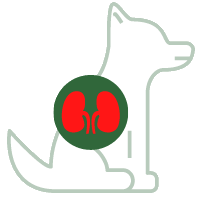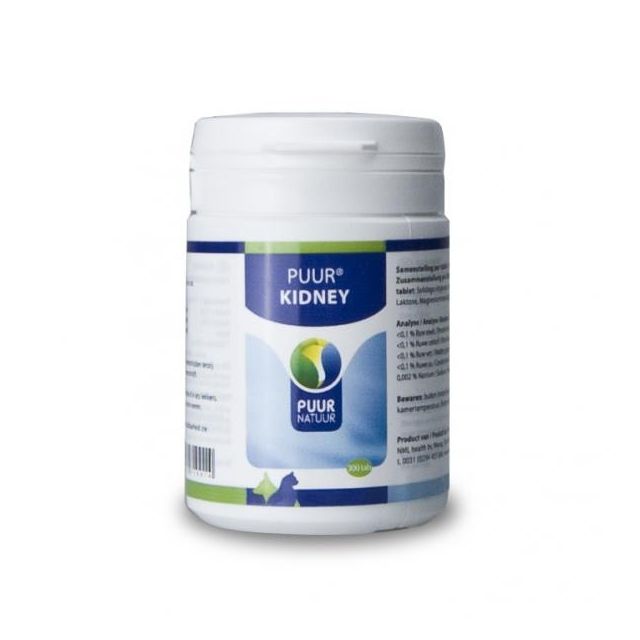Kidneys, bladder and urinary tract of the dog
The urinary tract of the dog runs from the kidneys, through the ureters, to the bladder, where the urine then exits via the urethra from the penis or vulva. The kidneys are among the most important organs of the body. Their main function is to maintain a good fluid balance and eliminate toxins. Pharmacy4pets helps you keep your dog's urinary tract healthy with a wide range of supportive products.
If you suspect that your dog has kidney problems or urinary issues, a visit to the vet is recommended. Urine analysis is an integral part of urinary tract problems. It's best to bring urine to your appointment. You can easily collect urine in this handy collection tray.
The dog's kidneys
Every dog has two kidneys: bean-shaped structures located high on the back, approximately at the last ribs.
The kidneys' main function is to filter the blood: all the blood passes through the kidneys, where in countless small 'filter factories' (called nephrons) useful substances (such as certain salts and proteins) are retained and waste products are removed. Urine is produced in the kidneys. A dog produces about 20 to 40 ml of urine per kilogram of body weight daily.
The dog's bladder
The bladder is actually just a storage organ. Urine is stored here until it's time to expel it, to urinate. The sphincter ensures that the bladder remains closed until the dog actively decides to open it and thus urinate.
The dog's urinary tract
Actually, the term 'urinary tract' encompasses the entire organ system from the kidneys to the vulva or penis, but here we mean the small tubes that run from the kidneys to the bladder and from the bladder to the penis or vulva.
From each kidney, one ureter runs to the bladder and from the bladder, ultimately, one urethra (or urinary duct) runs to the external genital opening.
Difference in urinary tracts between the male and female
The urogenital apparatus (the urinary tract) of male and female dogs differ anatomically considerably. In females, the urethra is short and wide, while in males, the urethra must make a curve and pass along the penis bone; therefore, the male urethra is much narrower and longer. This makes the path that bacteria must travel from the outside to the bladder much more difficult and longer in males than in females, making bacterial cystitis much less common in males than in females.
Symptoms of kidney diseases
- Drinking and urinating a lot or not producing urine at all (the latter is an emergency).
- Very watery urine.
- Nausea.
- Decreased appetite.
- Weight loss.
- Vomiting.
- General discomfort or weakness.
- In case of pyelonephritis: urinating frequently in small amounts, blood or pus in the urine, foul-smelling urine.
Kidney diseases
The most common kidney diseases in dogs are acute and chronic kidney disease and pyelonephritis. Kidney stones are also common.
Acute kidney disease can be caused, among other things, by an overdose of certain medications and toxins such as antifreeze or grapes. If treated in time, acute kidney disease is sometimes reversible. In other cases, the dog may die from it or the disease may progress to chronic kidney disease.
In case of chronic kidney disease (also called kidney failure), a large part of the nephrons of the kidney are no longer able to fulfill their function. Unfortunately, this is a progressive disease, to which the dog will eventually succumb. Fortunately, there are supportive products that can help maintain the quality of life of a dog with chronic kidney disease as best as possible. The mainstay in managing chronic kidney disease is a renal diet.
Pyelonephritis is a bacterial inflammation of the kidneys, which usually arises from neglected cystitis.
Symptoms of bladder and urinary problems
- Urinating frequently in small amounts.
- Pain when urinating.
- Blood or pus in the urine.
- Different color or odor of urine.
- Inability to hold urine.
- Drinking and urinating a lot.
- Licking at the genitals.
- Being generally sick.
- Inability to urinate (NB: this is an emergency!).
Diseases of the bladder or urinary tract
The most common problem with the dog's bladder and urinary tract is bacterial cystitis, which as mentioned above mainly occurs in female dogs.
Bladder stones and bladder grit are common, often in combination with bacterial cystitis. Tumors or polyps of the bladder are less common. With these handy test strips, you can check your dog's urine yourself (Note: this does not replace a veterinary examination).
Incontinence, the inability to hold urine, is seen regularly. If these urinary problems occur in puppies, the cause is often a poorly formed ureter (ectopic ureter), and in older dogs (especially in spayed females), the problem is usually a less functional bladder sphincter.
In case of suspicion of kidney, bladder, or urinary tract diseases, a good diagnosis by the veterinarian is essential. Pharmacy4pets offers a wide range of supportive products for the urinary tract such as dietary food for struvite crystals or dietary food for chronic kidney disease and various supplements. However, always consult your veterinarian before using these products, as incorrect use of these products can have undesired effects.
If you have any questions about our products or about urinary tract problems in your dog, please contact us.
















